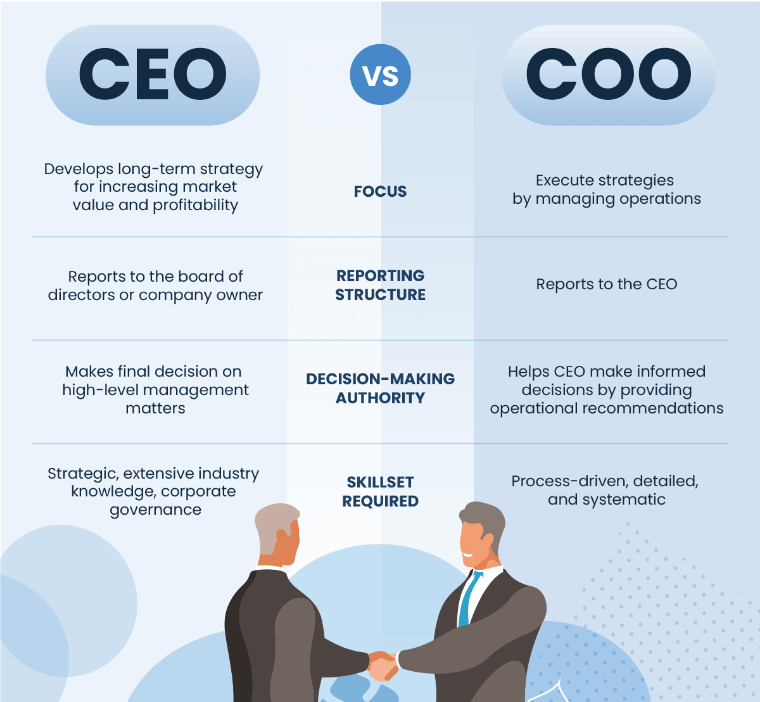The CEO and COO are top-level executives with distinct roles who commit themselves to leading companies toward operational excellence and governance. Forming a powerful duo, their symbiotic relationship is vital for companies to attain sustainable and profitable growth.
Explore below the key differences between CEO and COO, their roles, responsibilities, and how their teamwork benefits the company.
What is a CEO?

The chief executive officer (CEO) is the highest executive in all C-suites. They focus on increasing the market value and profit of companies by establishing strategic roadmaps across business functions. The board of directors elects the CEO to guide the company in navigating through the ever-changing market landscape. The CEO takes charge of exploring untapped business opportunities and addressing industry-specific challenges.
What is the role of a CEO?
CEOs have the final say on big company decisions, so their subordinates value their recommendations and have the authority to veto them as needed. In addition to making decisions, CEOs are also accountable for the following:
- Establish the strategic trajectory of a company: A CEO creates an all-encompassing strategy for the company. These strategies are commonly conveyed to the rest of the workforce using visual assets like roadmaps and dashboards, making performance evaluation and KPI tracking more efficient.
- Oversee overall operations across multiple business units: CEOs are accountable for the operational success of the entire company through their supervision and direction. They have many deputies, but their leadership at the top is a major driver of success.
- Instill a culture of risk awareness and management: The CEO strengthens risk assessment and management throughout the company, recognizing that both internal and external risks can have a significant long-term impact on the business. Leading by example, they instill in employees the importance of being able to assess and act on risks through training and seminars.
- Maintain a positive public reputation: The CEO is the primary face of companies in corporate activities, including investor meetings, gala nights, and fundraisers, trade shows, and industry conferences. They establish and sustain relationships with internal and external stakeholders. like investors and customers, to promote a positive market image of the company.
- Drive sustainable profitability: The CEO’s proficiency in handling financial data is vital when steering a business toward sustainable profitability. They use various reports and data sets from sales, marketing, and operations to identify financial risks, manage costs, identify growth opportunities, and invest for the future.
- Form the senior leadership team: Forming a formidable senior leadership team does not stop with hiring. CEOs fortify their senior management with leadership and management training, networking opportunities, and the delegation of bigger projects. These initiatives are beneficial in enhancing the competencies of leaders, boosting their morale, and increasing productivity.
Functions
What’s under CEO? When making decisions, CEOs consult with their senior management, particularly chief operating officers. Senior executives have more direct experience with their departments and are adept at providing CEOs with recommendations and perspectives, resulting in more efficient collaboration.
The CEO reports to the board of directors and provides periodic performance reports on crucial business developments. Depending on the company’s structure, the CEO also actively interacts with investors and stockholders to develop and sustain bonds for future business partnerships.
Salary and Reputation
As of September 2023, the average salary of a CEO in the United States ranges from 627,800 to 1,069,700 USD. Several factors are considered when deriving a compensation package for a CEO. Offers vary depending on expertise, industry experience, competence, geographical location, and size of the company.
The salary of CEOs has shown a massive increase in the past 44 years. According to the report of Economic Policy Institute, their pay has increased by 1,322.2% from 1978 to 2020.
The CEO position comes with prestige and generous exclusive perquisites, such as annual cash bonuses and incentives, lifestyle allowances, and stock ownership options. For example, Apple CEO Tim Cook is expected to get 49 million USD in 2023. The total compensation includes a basic salary of 3 million, cash incentives of 6 million, and stock awards of 40 million.
Qualifications
To qualify for the CEO position, an individual must exhibit exceptional industry expertise by showcasing a proven record of successfully managing a team, making sound company decisions and policies, and setting up highly effective strategies.
Candidates must initially possess relevant education, training, and certifications. A typical CEO may have completed education in bachelor fields in business, law, or engineering. Some CEOs achieve success with a doctorate, while others manage with a master’s degree. Additionally, some industries require their CEOs to have industry-specific professional certifications. For example, an accounting firm CEO must be a certified public accountant (CPA). Similarly, the architectural firm CEO must be a licensed architect.
Other qualifications, such as leadership and management skills, are also necessary for this role. Those skills are strategic development, critical thinking, risk management, problem-solving, public speaking, corporate governance and general management, and corporate finance.
What is a COO of a company?

Chief Operations Officers are accountable for the execution of the strategies established by the CEO through engaging actively in daily operations. They are widely referred to as the CEO’s right hand. COOs lead business operations such as marketing, sales, supply chain management, and finance.
What is the role of a COO?
As the deputy to the CEO, a COO’s main responsibilities include:
- Execution of the CEO’s strategic vision: The COO turns the big vision of CEOs into reality by being deeply involved in the internal affairs of the company. They represent the CEO to management teams and confer with them on operational issues.
- Lead daily operations of business functions: The COO heads operations across all business functions. For example, in production, they oversee the development and launch of new products. In marketing, they monitor sales operations and leads. They may also oversee customer service to ensure high and reliable service levels. This immersion in the day-to-day operations gives them leverage to get more familiar with its inner workings, making it far easier to make recommendations to the CEO.
- Oversee financial planning and budget processes: The COO regulates financial operations, from planning to disbursement. They ensure that the budget allocation aligns with the overall vision of the CEO.
- Supervise workforce: COOs are responsible for managing people within the company. They oversee integral HR processes such as hiring, training, payroll, and evaluation of performances.
Functions
The COO works more closely with senior managers and department heads than the CEO. This exposure gives them a better grasp of how the business works, influencing their viewpoints and recommendations to the CEO. Because of their familiarity, it is more intuitive for them to handle everyday operations and carry out the CEO’s overall strategy.
Salary and Reputation
The average salary of a COO in the United States ranges from 376,791 to 627,954 USD. Like CEOs, as the second in command, they receive benefits such as cash bonuses and incentives. Their total compensation package varies based on the company structure and culture.
Qualifications
Candidates for the COO position should be experts in executing corporate strategic plans, particularly with operations. They must be well-informed about the business functions and how they interplay to achieve harmony and increased productivity in the workplace. They should be highly analytical and critical thinkers capable of giving data-driven recommendations to the company. Because the role is more centered around people, COOs are expected to be systematic, detail-oriented, yet approachable.
COO vs CEO: Side-By-Side Comparison
Now that the CEO and COO meaning is known, explore other points of comparison on CEO vs COO. In this section, gain a better understanding of their differences:

Focus
The CEO takes responsibility for developing the long-term strategy for increasing the market value and profitability of the company. The COO, on the other side, is focused on execution and implementation. They are more involved in actual operations to ensure that all moving parts function harmoniously to achieve the set strategic goals of the CEO. In summary, CEO vs COO responsibilities: The CEO works on the strategy planning, while the COO executes it.
Reporting Structure
Which is higher CEO or COO? The CEO reports to the board of directors or the company owner. Meanwhile, the COO is accountable to the CEO. This organizational structure demonstrates the essential role of the COO in maintaining internal corporate communications.
COOs serve as a link between lower management and the CEO. As a result, the COO is responsible for providing progress updates and periodic reports to the CEO, allowing them to make more well-informed decisions.
Decision-Making Authority
The CEO makes the final decision on high-level management matters after deliberating with the COO. The COO’s perspectives are valuable to the CEO because they come from direct experience working with managers and heads. COOs have the authority to make decisions within their domains of responsibility, but the CEO has the final say and the right to denounce these at any moment.
Skillset Required
Any C-suite executives must exhibit vast industry knowledge and exceptional management abilities. However, for CEOs and COOs, specific skills are required to succeed and be effective in these positions.
For example, CEOs should be strategic thinkers, charismatic leaders, and influential. They devise strategies and unveil market opportunities with ease, given their extensive experience. Additionally, they are highly skilled public speakers and negotiators, which they use to build lasting relationships with internal and external stakeholders.
To efficiently coordinate operations and boost productivity, COOs must be more process-driven, systematic, and detailed. They can achieve this by establishing smooth workflows, enforcing defined standards and procedures, and relying on data and analytics to track performance and make decisions.
The Advantages of Having Both a CEO and a COO
A CEO-COO partnership lets a company capitalize on each leader’s skills, resulting in streamlined and more efficient workflows. Here are some examples of how CEO-COO teamwork can benefit a company:
Clearly defined roles and responsibilities
Clearly defined roles and responsibilities found on the committee charter for the CEO, COO, and other executives enable them to collaborate more effectively. These help them make sound decisions, reduce conflict, and hold each other accountable. As a result, it is easier for the CEO to focus on developing the overall strategy, while the COO leads operations of business functions and makes sure they align with the goals.
More informed decisions
Big company decisions are a byproduct of the deliberation between the CEO and COO. The on-the-ground perspectives of the COO give the CEO practical insights into internal operations, helping the two come up with more informed and grounded decisions.
Smooth succession and transition
In most cases, COOs are the successors to CEOs. As the second-in-command, COOs deeply understand the inner workings and strategic goals of the company. This advantage helps them smoothly transition into the CEO role and minimize business disruptions.
Frequently Asked Questions about CEO and COO

Some people find the duties and responsibilities of a CEO and COO confusing. This section answers the most frequently asked questions about these coveted corporate roles.
Who has more power than a CEO?
The board of directors ranks higher than the CEO. They are responsible for electing the CEO, as well as, dismissing them if necessary. The CEO delivers comprehensive periodic reports, which the board utilizes to regulate management and monitor the overall performance. They also lead the ongoing evaluation of the CEO’s performance, decisions, strategy, and output. The board of directors being at the top of the organization, has the authority to overturn wrong decisions by CEOs.
Who reports to the COO?
The COO typically has direct reports from department heads, such as the VPs of sales, marketing, finance, human resources, and supply chain. The COO heads operations and has close relationships with these departments and business functions.
Does every company need a COO?
According to a 2022 report by McKinsey, among the companies listed in the Fortune 500 and S&P 500, 40% had a COO in 2000. The number declined to its lowest in 2018 with only 32%. In 2022, numbers are showing that COOs might have a return because 40% of these prominent companies now have one in 2022.
Can one person be both a COO and a CEO?
A single person can fulfill the CEO and COO positions, particularly in small companies. A person must exhibit the attributes required for both roles to succeed. As a CEO, they have to determine the goals and strategies of the company. Meanwhile, as COO, they should work closely with departments to manage operations and maintain efficiency to attain those goals.
Are there similarities between a CEO and a COO?
Absolutely. The CEO and COO roles drive a company towards growth and profitability. Both are from the C-suite, which requires excellent leadership, strategic thinking, and problem-solving skills.
Empowering C-suites to Drive Corporate Governance Excellence

CEOs and COOs have heavy workloads, with calendars filled with strategy meetings, performance presentations, proposal approvals, and document reviews. With these happening all at once, senior executives must take the initiative in streamlining these processes for the team. Take the time and learn about the benefits of board portals and how they empower management teams to elevate their corporate governance.
Board portals, such as Convene, offer a paperless solution for CEOs, COOs, and other senior executives to digitize their workflows, from meetings to presentations, voting, announcements, and signatures. With cutting-edge security features such as document encryption, log-in authentication, audit trail, and flexible hosting options, leaders can ensure that all information circulating in the portal is safe, secure, and preserved.
Take your corporate governance to the next level and start by booking a free demo from Convene!
Jean is a Content Marketing Specialist at Convene, with over four years of experience driving brand authority and influence growth through effective B2B content strategies. Eager to deliver impactful results, Jean is a data-driven marketer who combines creativity with analytics. In her downtime, Jean relaxes by watching documentaries and mystery thrillers.


![How to Create a Board Skill Matrix + Template [Free Download]](https://cdn.azeusconvene.com/wp-content/uploads/2024Q3_Jul_Board-of-Directors-Skills-Matrix-Whitepaper-B-Colored.png)








